In my home, we have always cooked rice in an open pot of boiling water and drained the excess water off once the rice is cooked. This helps in removing the excess starch in rice (the resulting kanji vellam is used to starch clothes) and the grains remain separate, the way we like it.
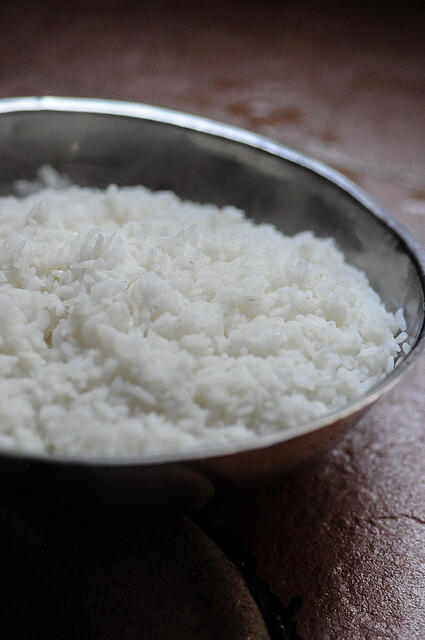
My in-laws consume raw rice which is cooked in a pressure cooker or rice cooker, always. The consistency is more sticky and this works well for the kind of rasam and kuzhambu the rice is served with, not to mention pongal and other dishes made with this rice.
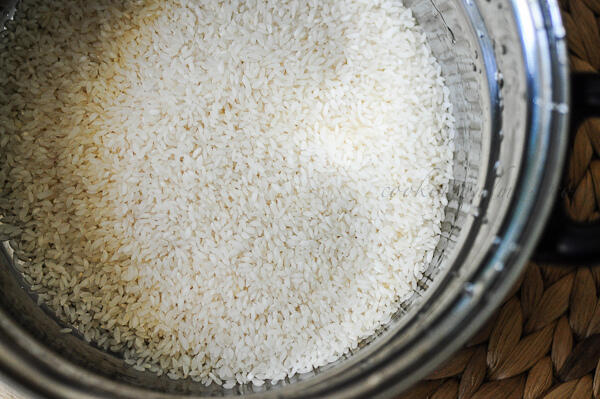 |
| Seeraga Samba Rice |
I use ponni par-boiled rice on a daily basis in Singapore (available in Fairprice in 5kg bags and all stores in Little India) and Basmati or Seeraga Samba rice for Biryani, Pulao, and other one-pot mixed rices.
While I use my rice cooker for the every day rice, I cook rice for biryani, pulao, differently and wanted to share the method with you. I get a lot of comments on my pulao posts asking how the rice grains remain separate after making the dish and the answer is – being able to control how much your rice gets cooked helps you get that consistency in biryani and pulao.
How to Cook Rice for Biryani, Fried Rice, Pulao
Preparation time: 30 minutes
Cooking time: 10 minutes
Makes 2.5 cups cooked rice
Ingredients:
1 cup of basmati rice or seeraga samba rice
3 cups of water
1 tsp of salt
How to Cook the Rice:
1. Wash and soak the rice in enough water to cover it for 30 mins.
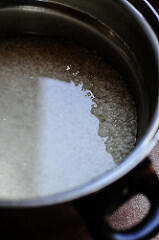
2. After 30 mins, drain the water completely, add 3 cups of fresh water (or enough to cover the rice by 2-3 inches) and place on the stove on medium flame.
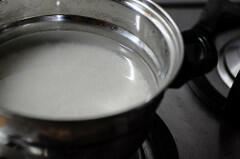
3. Add salt and bring to boil.
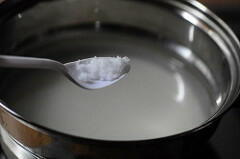
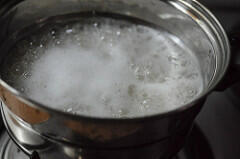
4. Once the water is boiling, lower flame and let the rice cook in the open pot for 10-12 mins. You will see the rice getting enlarged and the water level going down.
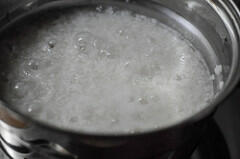
5. After 10 mins, check the grains to see if it’s cooked. Generally I pinch a grain or rice between my thumb and forefinger and see if it smushes smoothly. Or, just put some grains of rice in your mouth and bite into them to see if they are hard inside. It’s done when the rice is soft yet not mushy. It’s better to leave it a bit underdone than overdone if you are in doubt.
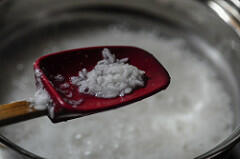
6. Switch off flame and immediately drain the rice in a colander. Let it sit on an uneven platform for 30 mins or so. You can fluff it with a fork midway so that the water drains out completely.

That’s it! You can use this rice for making biryani, pualo, fried rice, or any mixed rice variety. The grains will remain separate and the flavours will be nicely incorporated once you are done.
Tip: You can add a few drops of oil to the boiling water if you want. I sometimes do this but it’s not really super necessary.
Tip from a reader, Lakshmi: Add a few drops of lemon juice to the cooked rice when it’s hot and mix well. The colour of the rice will be super white.

Hello nags, Thanks for such a wonderful website… a true treausre. I found this discussion very interesting and informative. If I may add my two cents, I use the electric rice cooker and use basmati rice with 1 1/2 cups water to 1 cup, and add ghee or butter when rice is getting cooked. There is no need to drain or keeping an eye on the rice. It will automatically cook into separate soft grains, let it sit for while before mixing with the other ingredients…
Cheers!!
Manju
hi nagalakshmi,
been going through your suggestions for cooking rice perfectly for pulavs and fried rice. this has been the bane of my life till recently. I heard an anchor on a local tv channel suggest using 1.5 times water for cooking basmati rice for fried rice and it has worked perfectly well for me. I keep the pot covered partially through out the cooking process.
the other option is to cook with 3 times water in microwave for 15 min. the results again are excellent.
regards
lalitha
Useful info. Tks for sharing
Useful post Nags. I don't add salt to my rice. I cook my regular ponni rice in pressure cooker filled with water and I place a vessel (with rice+ water) and cook for 4-5 whistles. With basmati I cook in a pan with a fitting lid.
useful post..
I never drain the water from the rice the reasoning behind being that all the nourishment from the rice goes with it. Try it my way. I wash the rice (either Basmati or sona masoori rice) after soaking for 30 mts.or so) Drain that water out & add 2 cups of water & a tsp of oil bring it to a boil . After a few minutes of boiling cover the pot ,turn the heat down on the stove to only low.(level2). In about 12-15 mts. you will have beautiful well cooked rice. No need for any draining. Try.
Rama Sekharan
Thank you for the tip Rama. I was under the impression that what we are draining away is excess starch which is not that great for health anyway. Need to do more research on this 🙂 Certain rice that's used in Kerala is recommended to be consumed only cooked and drained this way though, that's why I have never felt draining water away after cooking rice is a bad thing.
That's right Archana, we use the drained rice in some for too – either to starch saris and cotton shirts or drink on a warm day with a pinch of salt per glass.
Also, the soaking is only for basmati and seeraga samba. I don't soak everyday ponni or raw rice.
If I may put my 2 bits. This method of draining rice is followed in Goa also and the water is used to make 'paaz" a soup kind of, sorry a kanji. The Goan use boiled rice especially the red kind of rice which has too much starch. But the drained water is put to use.
Rest I follow Rama Sekharan's method only I use my knuckles to measure the water level and I do not soak the rice.
Its Better to drain-off excess starch from rice. both basmathi and seeraga samba doesn't contain excess starch.. so draining is not necessary for these rice. moreover this process tend to lose the flavor of the rice.
but it is necessary for par-boiled rice, sona massori rice. because these contain so much of starch which will increase ur sugar level..
http://www.livestrong.com/article/273335-rice-glycemic-index/
Thank you sharing tips on how to cook rice, Parvathy
Thanks ladies
thanks for the tips! hopefully now when I cook Biryani, the grains would look separate.
If you a spoon of oil or ghee in the hot water the rice will be cooked with beautiful separated grains..which Wud be perfect for fried rice or biryan
Thanks Nags,
I longed to cook basmati this way, I tried once n had poured hot water over me. So never dared it again. This way of draining off water in colander is easy.
Rashmi
Hi Nags, I have tried adding a little lemon juice while cooking basmathi rice to give it that radiant white color. Works well!
Thanks for the great tip Lakshmi. I have added it to the post 🙂